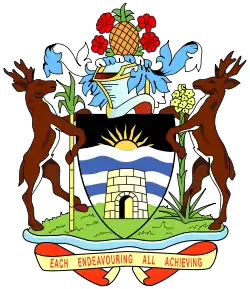| |||||||||||||||||||||||||
All 17 seats in the House of Representatives 9 seats needed for a majority | |||||||||||||||||||||||||
|---|---|---|---|---|---|---|---|---|---|---|---|---|---|---|---|---|---|---|---|---|---|---|---|---|---|
| Turnout | 61.12% ( | ||||||||||||||||||||||||
| |||||||||||||||||||||||||
 Results by constituency | |||||||||||||||||||||||||
| |||||||||||||||||||||||||
 |
|---|
General elections were held in Antigua and Barbuda on 17 April 1984,[1] the first after the country had become an independent Commonwealth realm in 1981.
The result was a victory for the governing Antigua Labour Party (ALP), whose leader Vere Bird was reelected as Prime Minister of Antigua and Barbuda. In contrast, the opposition vote was split between George Walter's new political vehicle, the United People's Movement, and the Progressive Labour Movement, Walter's former party from his pre-independence term as Premier.[2] The only non-ALP seat was won by a pro-ALP independent from Barbuda.[2] Voter turnout was 61.1%.[1]
Results
| Party | Votes | % | Seats | +/– | |
|---|---|---|---|---|---|
| Antigua Labour Party | 12,972 | 67.90 | 16 | +3 | |
| United People's Movement | 4,401 | 23.04 | 0 | New | |
| Progressive Labour Movement | 356 | 1.86 | 0 | –3 | |
| Independents | 1,375 | 7.20 | 1 | 0 | |
| Total | 19,104 | 100.00 | 17 | 0 | |
| Valid votes | 19,104 | 99.38 | |||
| Invalid/blank votes | 119 | 0.62 | |||
| Total votes | 19,223 | 100.00 | |||
| Registered voters/turnout | 31,453 | 61.12 | |||
| Source: Nohlen | |||||
References
- 1 2 Dieter Nohlen (2005) Elections in the Americas: A data handbook, Volume I, p66 ISBN 978-0-19-928357-6
- 1 2 Meditz, Sandra W.; Hanratty, Dennis M. (1987). "Antigua and Barbuda - Government and Politics". Caribbean Islands: A Country Study. Washington, D.C.: Federal Research Division, Library of Congress. Retrieved 22 January 2010.
This article is issued from Wikipedia. The text is licensed under Creative Commons - Attribution - Sharealike. Additional terms may apply for the media files.
.jpg.webp)
